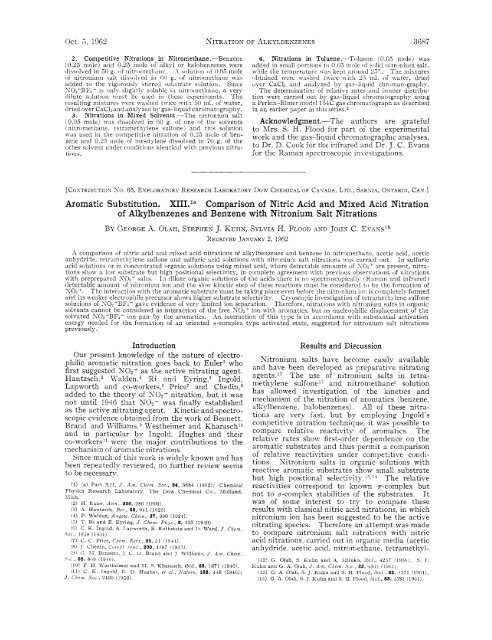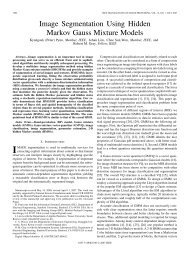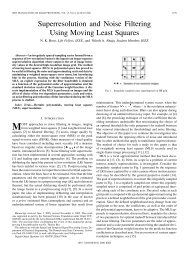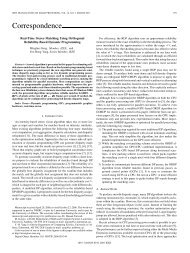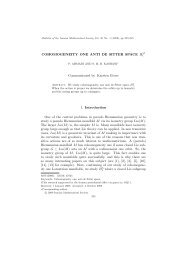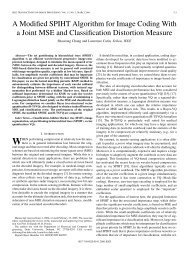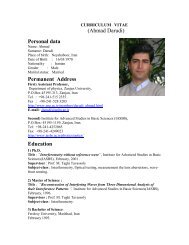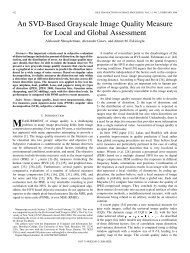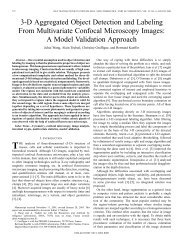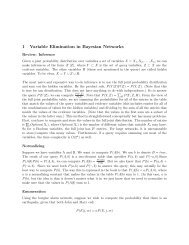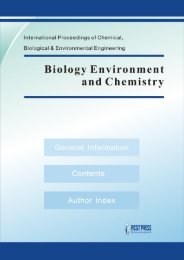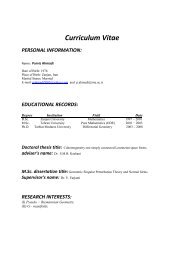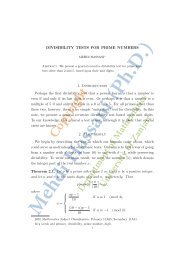Aromatic Substitution. XIII.la Comparison of Nitric Acid and Mixed ...
Aromatic Substitution. XIII.la Comparison of Nitric Acid and Mixed ...
Aromatic Substitution. XIII.la Comparison of Nitric Acid and Mixed ...
You also want an ePaper? Increase the reach of your titles
YUMPU automatically turns print PDFs into web optimized ePapers that Google loves.
Oct. 5, 1963 NITRATION OF A4LKYLBENZENES 3087<br />
2. Competitive Nitrations in Nitromethane.-Benzene<br />
(0.25 mole) <strong>and</strong> 0.25 mole <strong>of</strong> alkyl or halobenzenes were<br />
dissolved in 50 g. oi nitr~~~ncil~~~i~~. :\ solutioti <strong>of</strong> 0 0.5 inole<br />
I J ~ iiitroniuni salt tliswlvcd iii (i0 g. <strong>of</strong> iiitrorricth:irie \vas<br />
added to the vigorously stirred substrate sulutiou. Since<br />
S02+BF4- is only slightly soluble in nitrornethanc, a very<br />
dilute solution must bc used in thcsc experinients. The<br />
resulting mistures i\-ere waslied twice ivitli 1111. <strong>of</strong> water,<br />
dried over CaCL <strong>and</strong> analyzed by gas-liquid chromatography.<br />
3. Nitrations in <strong>Mixed</strong> Solvents.-The nitroniuni salt<br />
(0.05 mole) n-as dissolved in 60 g. <strong>of</strong> one <strong>of</strong> the solvents<br />
(nitromethane, tetramethylene sulfone) <strong>and</strong> this solution<br />
!vas used in the competitive nitration <strong>of</strong> 0.25 mile <strong>of</strong> benzene<br />
arid 0.22 mole <strong>of</strong> mesitylene dissolved in 70 g. <strong>of</strong> the<br />
other solvent under crmditicins identical with previous nitrations.<br />
4. Nitrations in Toluene.-Toluene (0.05 mole) was<br />
added in srnall portions to 0.05 mole <strong>of</strong> solid nitronium salt,<br />
while tlie ternperatur~ \vas kept iLround 23'. The inistures<br />
ol,tained wcre washrd tiiice \zit11 2.5 nil. <strong>of</strong> \\-ater, dried<br />
over CaCln mi1 analyzed by gas-liquid chromatography.<br />
The determination <strong>of</strong> re<strong>la</strong>tive rates <strong>and</strong> isoiner distribution<br />
were carried out b>- gas-liquid chromatograph>- using<br />
a Perkin-Elmer inodt.1 I54C gas chromatograph as described<br />
in an earlier paper in this series.2<br />
Acknowledgment.-The authors are grateful<br />
to Mrs. S. H. Flood for part <strong>of</strong> the experimental<br />
work <strong>and</strong> the gas-liquid chromatographic analyses,<br />
to Dr. D. Cook for the infrared <strong>and</strong> 1)r. J. C. Evans<br />
for the Ranian spectroscopic investigations.<br />
[COSTRIBCTION SO. 65, EXPLORATORY RESEARCH LABORATORY DOW CHEMICAL OF CATADA, LTD., SARSIA, ONTARIO, CAN.]<br />
<strong>Aromatic</strong> <strong>Substitution</strong>. <strong>XIII</strong>.<strong>la</strong> <strong>Comparison</strong> <strong>of</strong> <strong>Nitric</strong> <strong>Acid</strong> <strong>and</strong> <strong>Mixed</strong> <strong>Acid</strong> Nitration<br />
<strong>of</strong> Alkylbenzenes <strong>and</strong> Benzene with Nitronium Salt Nitrations<br />
BY GEORGE -4. OLAH, STEPHEN J. KUHN, SYLVIA H. FLOOD<br />
RECEIVED JANUARY 2, 1962<br />
AND Jom C. Evili~s~~<br />
X coniparisoii <strong>of</strong> nitric acid arid mixed acid nitrations <strong>of</strong> alkylbenzenes <strong>and</strong> benzene in nitromethane, acetic acid, acetic<br />
anhydri-le, tetramcthyletie sulfone <strong>and</strong> sulfuric acid solutions with nitroniurri salt nitrations \vas carried out. In sulfuric<br />
acid solutions or in concentrated organic solutions using mixed acid, where detectable amounts ~f SO? + are present, nitrations<br />
s11o;v a low substrate but high positional selectivity, in complete agreement with previous observations <strong>of</strong> nitrations<br />
with preprepared SO2+ salts. In dilute organic solutions <strong>of</strong> the acids there is no spectroscopicall>- ( Kninan <strong>and</strong> infrared)<br />
detectable amount <strong>of</strong> nitroniuin ion <strong>and</strong> the slow kinetic step <strong>of</strong> these reactions must be considered to be the formation <strong>of</strong><br />
SO?+. The ititeraction lvith the aromatic substrate must be taking p<strong>la</strong>ce even before the nitroniurn iwi is complctel>- formed<br />
<strong>and</strong> its weaker electrophile precursor shows higher substrate selectivity. Cryosco;iic investigation <strong>of</strong> tetramethylene sulfone<br />
solutions <strong>of</strong> SOr+BF4- gave evidence <strong>of</strong> very limited ion separation. Therefore, nitrations with nitroniuin salts in organic<br />
solvents cannot he considered as interaction <strong>of</strong> the free NOp+ ion with aromatics, but as nucleo2hilic disp<strong>la</strong>cement <strong>of</strong> the<br />
solvated SOu"BF4- ion pair by the aromatics. Aln interaction <strong>of</strong> this ti-pe is in accordance with substantial activation<br />
energy needed for the formation <strong>of</strong> an oriented n-complex type activated state, suggested for nitronium silt nitrations<br />
previously<br />
Introduction<br />
Our present knowledge <strong>of</strong> the nature <strong>of</strong> electrophilic<br />
aromatic nitration goes back to Euler2 who<br />
first suggested NO*+ as the active nitrating agent.<br />
Hant~sch,~ n'alder~,~ Ri <strong>and</strong> Eyring,j Ingold,<br />
Lapworth <strong>and</strong> co-workers,E Price' <strong>and</strong> Chedin,8<br />
added to the theory <strong>of</strong> Iv02+ nitration, but it was<br />
not until 194G that N02T was finally established<br />
as the active nitrating agent. Kinetic <strong>and</strong> spectroscopic<br />
evidence obtained from the work <strong>of</strong> Bennett,<br />
Br<strong>and</strong> <strong>and</strong> M7illiams, \Vestheher <strong>and</strong> KharaschlO<br />
<strong>and</strong> in particu<strong>la</strong>r by Ingold, Hughes <strong>and</strong> their<br />
co-workers" were the major contributions to the<br />
mechanism <strong>of</strong> aromatic nitrations.<br />
Since much <strong>of</strong> this work is widely known <strong>and</strong> has<br />
been repeatedly reviewed, no further review seems<br />
to be necessary.<br />
(1) (a) Part XII, J. Am. Chem. Soc., 84, 3684 (1902); Chemical<br />
Physics Research Laboratory, The Dow Chemical Co., A4id<strong>la</strong>nd,<br />
Xlich.<br />
(2) H Euler, Aniz., 330, 280 (1903).<br />
(3) A. Hantzsch, Be?., 58, 911 (192.5).<br />
(4) P. XValden, Angew. Chern., 37, 390 (1924).<br />
(6) T. Ri <strong>and</strong> E. Eyring, J. Chem. Phys., 8, 433 (19tO).<br />
(6) C. K. Ingold, A. Lagworth, E. Rothstein <strong>and</strong> I). Ward, J. Chem.<br />
soc., 1ni9 (1!)31j,<br />
(7) e. C. Price, Cizem. Revs., 29, 21 (1941).<br />
(8) J Chedin, Cui~ipl reml., 200, 1:;97 (193:).<br />
('2) (> RI. 13ennet1, J C. U. Br<strong>and</strong> <strong>and</strong> J. \i'illiams, J Am. Chein.<br />
jiic , 68, 809 (194(i).<br />
(10) F. H Xyestheimer <strong>and</strong> RI. S. Kharasch, ibid., 68, 1871 (1916).<br />
(11) C. K. Ingold, 1,:. U. Hughes, el ai., Suture, 168, 448 (1946);<br />
J. Chem. SOL., 2400 (IXO).<br />
Results <strong>and</strong> Discussion<br />
Nitronium salts have become easily avai<strong>la</strong>ble<br />
<strong>and</strong> have been developed as preparative nitrating<br />
agents.'? The use <strong>of</strong> nitronium salts in tetra-<br />
methylene sulfoneI3 <strong>and</strong> nitromethaneb solution<br />
has allowed investigation <strong>of</strong> the kinetics <strong>and</strong><br />
mechanism <strong>of</strong> the nitration <strong>of</strong> aromatics (benzene,<br />
alkylbenzene, halobenzenes) . All <strong>of</strong> these nitra-<br />
tions are very fast, but by employing Ingold's<br />
competitive nitration technique, it was possible to<br />
compare re<strong>la</strong>tive reactivity <strong>of</strong> aromatics. The<br />
re<strong>la</strong>tive rates show first-order dependence on the<br />
aromatic substrates <strong>and</strong> thus permit a comparison<br />
<strong>of</strong> re<strong>la</strong>tive reactivities under competitive condi-<br />
tions. Nitronium salts in organic solutions with<br />
reactive aromatic substrates show small substrate<br />
but high positional selectivity. The re<strong>la</strong>tive<br />
reactivities correspond to known n-complex but<br />
not to cr-complex stabilities <strong>of</strong> the substrates. It<br />
was <strong>of</strong> some interest to try to compare these<br />
results with c<strong>la</strong>ssical nitric acid nitrations, in which<br />
nitronium ion has been suggested to be the active<br />
nitrating species. Therefore an attempt was made<br />
to compare nitronium salt nitraticns with nitric<br />
acid nitrations, carried out in organic media (acetic<br />
anhydride, acetic acid, nitroniethane, tetramethyl-<br />
(12) G. O<strong>la</strong>h, S Kuhn <strong>and</strong> A. lflinko, ibii., 4237 (1!13iI, S J.<br />
Kuhn <strong>and</strong> G. A. o<strong>la</strong>h, J. Am. Chern. soc., 83, 45lil (IUljl)<br />
(18) G. A O<strong>la</strong>h, S. J. Kuhn <strong>and</strong> S. H. I?lood, ibid., 83, 4571 (19iil).<br />
(14) G. A. O<strong>la</strong>h, S. J. Kuhn <strong>and</strong> S. H. Flood, ibrd., 83, %381 (1961).
3688 G. A. OLAH. S. J. KUHX, S. H. FLOOD AND J C ETANS Irol. s4<br />
ene sulfone) <strong>and</strong> with mixed acid nitrations in the<br />
same solvent systems.<br />
Nitration with <strong>Nitric</strong> <strong>Acid</strong> in Organic Solvents.---<br />
IYith nitric acid (used both as solvent <strong>and</strong> as<br />
nitrating agent) Ingold has found that nitrations<br />
are first order with respect to aromatic compounds.<br />
Allthough, according to Kaman spectroscopic ob-<br />
servations, :: anhydrous nitric acid contains ap-<br />
proximately lY0 <strong>of</strong> nitronium ion, solutions <strong>of</strong><br />
nitric acid in organic solvents such as nitromethane<br />
contain no detectable amount <strong>of</strong> nitronium ion.<br />
Ingold, Hughes <strong>and</strong> co-workers have found that<br />
sufficiently reactive aromatic compounds (benzene,<br />
toluene, ethylbenzene, etc.) exhibit, in nitrations in<br />
nitromethane solutions, zeroth order kinetics, ;.e.,<br />
the reaction rates are independent <strong>of</strong> the nature or<br />
concentration <strong>of</strong> the substrate indicating that the<br />
aromatic compound takes no part in the rate-de-<br />
termining step. This step must therefore be limited<br />
to the nitric acid (with the possible assistance <strong>of</strong> the<br />
solvent) <strong>and</strong> was found to be the formation <strong>of</strong> X02+.<br />
The necessary- condition in the formation step <strong>of</strong><br />
the nitronium ion is that the rate <strong>of</strong> the recombi-<br />
nation <strong>of</strong> nitronium ion with water should be much<br />
slower than the rate <strong>of</strong> reaction <strong>of</strong> the nitronium<br />
ion with the aromatic compound. In nitro-<br />
methane solution there will be at the start <strong>of</strong> the<br />
reaction a minute concentration <strong>of</strong> water arising<br />
from the ionic self-dehydration <strong>of</strong> the nitric acid.<br />
During the reaction this will be increased, but the<br />
water concentration will always be much less than<br />
that in the partly aqueous solution. In nitro-<br />
methane solution the zeroth order rate was ob-<br />
served by Ingold <strong>and</strong> Hughes in almost all cases<br />
involving compounds with reactivities equal to or<br />
greater than that <strong>of</strong> benzene. The addition <strong>of</strong><br />
small quantities <strong>of</strong> water to nitromethane has little<br />
effect on the zeroth order rate. This is expected,<br />
since water does not enter into the pre-equilibrium<br />
step <strong>and</strong> therefore does not reduce the concentra-<br />
tion <strong>of</strong> the nitracidium ion. IThen more water is<br />
added, a point is reached where the water competes<br />
with the aromatic compound for the limited supply<br />
<strong>of</strong> the nitronium ion. The kinetics then change to<br />
a first-order form. 16<br />
The re<strong>la</strong>tive reactivity <strong>of</strong> toluene <strong>and</strong> benzene in<br />
competitive nitration with nitric acid in nitro-<br />
methane was found by Ingold" to be 21, using<br />
a di<strong>la</strong>tometric technique. Employing gas-<br />
liquid chromatography as an analytical method,<br />
the nitric acid nitration <strong>of</strong> benzene. toluene, ethyl-<br />
benzene, $-xylene <strong>and</strong> mesitylene were cornpared<br />
in competitive experiments (Table I). The results<br />
are in excellent agreement with Ingold's data for<br />
the toluene : benzene reactivity ratio <strong>and</strong> also<br />
establish high substrate selectivity <strong>and</strong> the usual<br />
isomer distributions in the nitration <strong>of</strong> the other<br />
alkylbenzenes.<br />
<strong>Nitric</strong> acid nitration <strong>of</strong> toluene <strong>and</strong> benzene in<br />
acetic anhydride <strong>and</strong> acetic acid solutions was in-<br />
vestigated by Ingold <strong>and</strong> Hughes during their<br />
sTTstematic study <strong>of</strong> nitrations." Knowles.<br />
Korman <strong>and</strong> RaddaI6 redetermined re<strong>la</strong>tive rates<br />
(I.?) E. 13. Hughes, C K. Ingold <strong>and</strong> R R. Pearsun, .I CIi~?ii. .So(.,<br />
4957 (1958).<br />
(It!) J. R Knowlep. R 0 C. Sorman <strong>and</strong> C,. K. RadBa, J. Chriii<br />
Sac., 48%
Oct. 5, 1962 NITRATION OF ALKYLBENZENES 3689<br />
aromatic compound <strong>and</strong> the concentration <strong>of</strong><br />
nitronium ion.<br />
<strong>Mixed</strong> acid nitration <strong>of</strong> aromatic hydrocarbons<br />
using only excess <strong>of</strong> aromatics as solvent or using<br />
sulfuric acid as solvent is not entirely suitable for<br />
kinetic investigations. <strong>Mixed</strong> acid forms a hetero-<br />
geneous system with aromatic hydrocarbons ; there-<br />
fore competitive nitrations can be carried out only<br />
under conditions not suitable for kinetic work.<br />
Increasing the velocity <strong>of</strong> stirring (by applying a<br />
vibrational stirrer) allowed some informative ex-<br />
periments to be carried out with this system. The<br />
data (Table 11) are, <strong>of</strong> course, only informative<br />
because <strong>of</strong> differences in rate <strong>of</strong> diffusion into the<br />
acid <strong>la</strong>yer <strong>and</strong> <strong>of</strong> solubility <strong>and</strong> because some<br />
dinitration takes p<strong>la</strong>ce.<br />
ortho me<strong>la</strong> pava<br />
Benzene 1.0<br />
Toluene 1.24 56.4 4.8 38.4<br />
o-Xylene 1.02 3-Sitro-o-xylene 5570<br />
4-Sitro-a-xylene 45%<br />
vz-Xylene 0.80 2-Nitro-m-xylene<br />
4-Sitro-vi-xylene<br />
14%<br />
86 :G<br />
p-Xylene 1.09<br />
Mesitylene 0.68<br />
agent, in the other a 75yo solution. According<br />
to spectroscopic data in the 30yG solutions there<br />
is no detectable amount <strong>of</strong> Nosf, whereas in the<br />
-- (~7~<br />
solutions 5-7.5 weight per cent. NOz+ is pres-<br />
ent.<br />
The nitration data obtained are summarized in<br />
Tables I11 <strong>and</strong> IV.<br />
TABLE I11<br />
COMPETITIVE NITRATION OF BESZESE ASD XLKYLBENZENES<br />
WITH 3070 SOLUTION OF MIXED BCID IS TETRAMETHYLENE<br />
SULFONE ASD ACETIC ACID AT 25'<br />
Isomer distribution,<br />
kar/ 7"<br />
<strong>Aromatic</strong> Solvent kbPnzene ortho me<strong>la</strong> pava<br />
Benzene Tetramethylene 1.0<br />
Toluene sulfone 28 62.0 3.4 34.6<br />
TABLE I1<br />
Ethylbenzene 24 50.3 3.6 46.1<br />
COMPETITIVE SITRATION<br />
OF BEXZENE AND XLKYLBESZESES Isopropyl-<br />
TVITH MIXED .ACID AT 25'<br />
benzene<br />
p-Xylene<br />
Heterogeneous, non-kinetic conditions<br />
Mesitylene<br />
13.8 43.2 4.5 52.3<br />
> 500<br />
> 1000<br />
Benzene .Icetic acid 1.0<br />
Toluene<br />
p-Xylene<br />
Mesitylene<br />
21<br />
> 500<br />
> 1000<br />
56.5 3.1 40.4<br />
TABLE IT<br />
COMPETITIVE KITRATION OF BESZENE ASD A"LKYLBENZEXES<br />
TVITH 757~ SOLUTION OF MIXED *ACID IN TETRAMETHYLENE<br />
SULFOSE AND ACETIC .ICID AT 25'<br />
ka/ Isomer distribution, 7c<br />
<strong>Aromatic</strong> Solvent kbenaene ovtho me<strong>la</strong> pava<br />
Benzene Tetramethylene 1 .0<br />
Toluene sulfone 1.60 56.3 2 6 41.0<br />
Ethylbenzene 1.35 44.7 2.0 63.3<br />
o-Xylene 0.9<br />
m-Xylene 1.1 15.37" P-SO?-m-xylene<br />
$-Xylene 1 .8 84.7% 4 XOI-m-xylene<br />
Mesitylene 0.33<br />
Benzene Acetic acid 1.0<br />
Toluene 2.13 58.1 1.9 40.0<br />
m-Xylene 1 .27 16.37c0 2-Pl'Or-?n-xylene<br />
83 87c 4-SO?-m-xylene<br />
\X7ith all the shortcomings <strong>of</strong> the heterogeneous<br />
nitration technique, these informative results<br />
show, however, marked resemb<strong>la</strong>nce to nitronium<br />
salt nitrations, but not to nitric acid nitration in<br />
organic solvents.<br />
In addition to the above-mentioned factors<br />
influencing heterogeneous reactions, lower re<strong>la</strong>tive<br />
rates <strong>and</strong> ortho isomer ratios point to the fact that<br />
in mixed acid the NO?+ salt must be solvated to a<br />
substantial degree by solvent acid; steric factors<br />
therefore may p<strong>la</strong>y an increasingly important role.<br />
Nitration with <strong>Mixed</strong> <strong>Acid</strong> in Organic Solvents.-<br />
Spectroscopic investigation <strong>of</strong> solutions <strong>of</strong> mixed<br />
acid in organic solvents (to be discussed <strong>la</strong>ter)<br />
shows that the NO2+ ion concentration in tetramethylene<br />
sulfone solution drops at around 60<br />
volume per cent. acid below the spectroscopically<br />
determinable limit. In acetic acid the limiting<br />
concentration is abcut 30 volume per cent. <strong>and</strong> in<br />
nitromethane about 25 volume per cent. mixed<br />
acid.<br />
Homogeneous nitrations <strong>of</strong> benzene <strong>and</strong> alkylbenzenes<br />
with mixed acid can be carried out in<br />
organic solvents, such as tetramethylene sulfone<br />
<strong>and</strong> acetic acid. Sitromethane cannot be used,<br />
because upon the addition <strong>of</strong> the hydrocarbon the<br />
acid <strong>la</strong>yer separates from the previously homogeneous<br />
solution. Acetic anhydride, as mentioned<br />
previously, reacts very vigorously with mixed<br />
acid to form acetyl nitrate, <strong>and</strong> cannot be used as<br />
solvent. Competitive nitration <strong>of</strong> benzene <strong>and</strong><br />
alkylbenzenes was carried out by adding the solutions<br />
<strong>of</strong> mixed acid to the stirred solution <strong>of</strong> the<br />
substrates at 25'. Two different sets <strong>of</strong> experiments<br />
were carried out. In one a 307, solution <strong>of</strong><br />
mixed acid in the solvent was used as nitrating<br />
The concentrations mentioned above refer only<br />
to the concentration <strong>of</strong> the nitrating acid (HsS04 +<br />
HN03) in the solvent. Upon addition <strong>of</strong> the substrates<br />
in the same solvent the actual concentration<br />
is further reduced (see Experimental part).<br />
Since it was established in previous work that NO2+<br />
nitrations <strong>of</strong> benzene <strong>and</strong> alkylbenzenes are very<br />
fast, it was suggested that NO2+ ions present in the<br />
solutions <strong>of</strong> the nitrating agent will react with the<br />
substrate before any substantial changes due to<br />
dilution <strong>of</strong> the solution, leading to formation <strong>of</strong><br />
nitric acid <strong>and</strong> decrease <strong>of</strong> the amount <strong>of</strong> N02+.<br />
In competitive rate determinations the actual<br />
amount <strong>of</strong> nitration taking p<strong>la</strong>ce is <strong>of</strong> no importance;<br />
therefore only slight interference is to be<br />
expected because <strong>of</strong> the formation <strong>of</strong> some nitric<br />
acid, which reacts much more slowly than NO*+<br />
ions.<br />
<strong>Mixed</strong> acid nitration <strong>of</strong> benzene <strong>and</strong> alkylbenzenes<br />
in dilute (3Oyo) tetramethylene sulfone <strong>and</strong><br />
acetic acid solution showed close simi<strong>la</strong>rity to<br />
nitric acid nitrations in the same solvents (high<br />
substrate <strong>and</strong> high positional selectivity).<br />
Nitrations with concentrated (757,) solutions<br />
<strong>of</strong> mixed acid showed good agreement with pre-
3690 G. A. OLAH, S. J. KUHK, S. H. FLOOD AND J. C. E~~1n-s 1-01, s4<br />
viously reported nitrations <strong>of</strong> benzene <strong>and</strong> alkyl-<br />
benzenes with NO2+ salts.<br />
Thus nitrations with mixed acid, when carried<br />
out in concentrated organic solutions containing<br />
spectroscopically demonstrated amounts <strong>of</strong> NO2+,<br />
show close simi<strong>la</strong>rities with nitronium salt nitr:t-<br />
tions. <strong>Mixed</strong> acid nitrations in more dilute or-<br />
ganic solutions, not containing detectable amounts<br />
<strong>of</strong> NO:! 4, however, show much higher substrate<br />
selectivity (but practically unchanged isomer<br />
distributions), simi<strong>la</strong>r to results reported by Ingold<br />
<strong>and</strong> Hughes for kinetic nitrations with nitric acid<br />
in these solvents, or to those obtained in nitric<br />
acid nitrations in the present work. It must be<br />
concluded therefore that (a) nitrations in dilute<br />
organic solutions involve the formation <strong>of</strong> the<br />
active nitrating agent as the rate-determining<br />
step <strong>and</strong> (bj the interaction <strong>of</strong> aromatic substrates<br />
with the nitrating agent involves not free SO2+,<br />
but a weaker electrophilic precursor <strong>of</strong> it, probably<br />
HsNO?+. SOs+ as such is formed only- after it is<br />
already associated with the aromatic substrate.<br />
This may exp<strong>la</strong>in why, as Ingold found, the re-<br />
action <strong>of</strong> KO2+ is much faster with aromatics, than<br />
with water.<br />
The experimental data point to the fact that the<br />
reaction <strong>of</strong> KO2+ with water in organic solvents can-<br />
not be considered as markedly slower than the re-<br />
action <strong>of</strong> NO?T with the aromatic substrates.<br />
The avai<strong>la</strong>bility <strong>of</strong> stable nitronium salts allows<br />
direct competitive experiments on the nitration<br />
rate <strong>of</strong> water, benzene, toluene (<strong>and</strong> fluorobenzene) .<br />
LTsing tetramethylene sulfone as solvent, competi-<br />
tive nitrations <strong>of</strong> equimo<strong>la</strong>r quantities <strong>of</strong> hydro-<br />
carbon <strong>and</strong> water were carried out with NO?+BFd-.<br />
The products were analyzed by gas-liquid chromatography.<br />
The data are summarized in Table V.<br />
TABJ,E 1'<br />
COMPETITIVE KITRATIOS<br />
(TOLUESE, FLUOROBESZENE)<br />
OF BENZESE<br />
AND WATER WITH XO?+<br />
BF4- IX TETRAMETHTLESE SULFOSE SOLUTION AT 25'<br />
LVater 1 .o<br />
Benzene 1.17<br />
Toluene 1.7i<br />
Fluorobenzene 0.55<br />
Under these conditions benzene reacts only very<br />
slightly faster than water with NO?+BF4-. The<br />
above data also permit calcu<strong>la</strong>tion <strong>of</strong> the re<strong>la</strong>tive<br />
toluene : benzene <strong>and</strong> fluorobenzene : benzene ni-<br />
tration rates. These are : ktoluene : kbenzene = 1.t52,<br />
kffuorobenzene : kbenzene = 0.47. The correspondence<br />
with previous data measured in direct competitive<br />
nitration <strong>of</strong> the aromaticsL3 (e.g., 1.6i <strong>and</strong> 0.45)<br />
is quite good.<br />
Infrared <strong>and</strong> Raman Spectroscopic Investigation<br />
<strong>of</strong> Nitronium Tetrzfluoroborate <strong>and</strong> <strong>of</strong> <strong>Mixed</strong><br />
<strong>Acid</strong> Solutions in Organic Solvents.--So apparent<br />
difference in the infrared <strong>and</strong> Raman absorption <strong>of</strong><br />
NO2+ in nitroniurn salts was observed whether the<br />
spectra <strong>of</strong> solid salts or their solutions in organic<br />
solvents with varying dielectric constants. such<br />
as tetramethylene sulfone, nitromethane or acelic<br />
acid, were taken. The identity <strong>of</strong> the spectra under<br />
such varying conditions is best exp<strong>la</strong>ined by as-<br />
suming that as in the crystal <strong>la</strong>ttice, where NO:'<br />
is in strong coulombic interaction with the anion,<br />
a somewhat simi<strong>la</strong>r situation also exists in solution.<br />
This suggestion <strong>of</strong> NO?+ being present in solution<br />
in the form <strong>of</strong> io11 pairs (or higher associated ion<br />
clusters, which <strong>of</strong> course in turn can be solvated)<br />
is further substantiated by cryoscopic investiga-<br />
tion <strong>of</strong> the solutions.<br />
Iianian <strong>and</strong> infrared spectroscopic investigations<br />
<strong>of</strong> solutions <strong>of</strong> nitric acid in the organic solvents<br />
used in these investigations (acetic acid, acetic<br />
anhydride, nitromethane <strong>and</strong> tetramethylene sul-<br />
fone) gave no evidence <strong>of</strong> the presence <strong>of</strong> free NO?+<br />
ions. These observations are in agreemcnt with<br />
previous data.<br />
In order to gain further information on mixed<br />
acid solutions in organic solvents, systems suitable<br />
for homogeneous kinetic nitrations, it was necessary<br />
to determine by Raman <strong>and</strong> infrared spectroscopy<br />
the KO2+ concentrations <strong>of</strong> these solutions at dif-<br />
ferent concentrations.<br />
-411 the spectroscopic data were obtained using<br />
a nitric acid: sulfuric acid mole ratio <strong>of</strong> 1 : 1 pre-<br />
pared from nitric acid, 15% oleum <strong>and</strong> SG%<br />
sulfuric acid. Raman spectra were obtained<br />
using a Hilger photoelectric 'photographic instru-<br />
ment with 435s A. excitation; the inverse disper-<br />
sion in this region is 7 .k.,lmm. when photoelectric<br />
recording is used <strong>and</strong> 16 A. ;mm. for photographic<br />
recording. The intensity was obtained photoelectrically<br />
<strong>and</strong> all solutions were scanned iminediately<br />
after preparation.<br />
Infrared spectra were obtained using a prismgrating<br />
instrument constructed by Herscher";<br />
slit widths <strong>of</strong> the order <strong>of</strong> 2 cm.-' were used. Sohtions<br />
were held between AgCl p<strong>la</strong>tes <strong>and</strong>, although<br />
the film thicknesses were not known, the qualitative<br />
intensity data obtained were reproducible<br />
<strong>and</strong> satisfactory for our purposes.<br />
The results are illustrated in Fig. 1, in which the<br />
re<strong>la</strong>tive concentration <strong>of</strong> NO2+ ion is plotted against<br />
the volume percentage <strong>of</strong> mixed acid in the organic<br />
solvent. Cnity on the SO2+ concentration scale<br />
is 5.6 mo<strong>la</strong>r. For the tetramethylene sulfone<br />
<strong>and</strong> the acetic acid solutions the Raman b<strong>and</strong> <strong>of</strong><br />
the NO?+ ion at 1400 cm-I ?? was used as the concentration<br />
measure, <strong>and</strong> all solutions were run<br />
run under these<br />
under identical conditions. Also . .<br />
same conditions was a nitric-sulfurlc acid mixture in<br />
which the sulfuric acid was in suEcient excess to<br />
convert the nitric acid entirely into the NC2+ ion.<br />
In this way the Nos+ ion concentration in all solu-<br />
tions was estimated. Uncertainties are <strong>of</strong> the<br />
order <strong>of</strong> .t47,. A linear re<strong>la</strong>tion between inten-<br />
sity <strong>and</strong> concentration was assumed <strong>and</strong> no cor-<br />
rections for refractive index effects were applied.<br />
but these are not expected to be <strong>la</strong>rge enough to<br />
influence the conclusions reached. Curves a <strong>and</strong><br />
b show that the limit <strong>of</strong> detection <strong>of</strong> KO?+ is at-<br />
tained at a higher mixed-acid concentration in<br />
acetic acid solvent than in tetramethylene sulfone.<br />
Photographic Raman spectra, in which the sensi-<br />
tivity is greater, confirmed the approximate limits<br />
<strong>and</strong> further confirmation was derived from the<br />
infrared yeak-intensity measurenients matl~ 011<br />
(21) I. W. Herscher. .Sppilrochiin. Arlo. 11, 9ill (l!l.i!J)<br />
(22) D. J. AIillen, .\-ulzirt~, 168, -IS0 (IWiI).
Oct. 5, 1962 SITRATION OF ALKYLBENZENES 3691<br />
the b<strong>and</strong> at 2375 cm.-', which is due to the asym-<br />
metric stretching mode <strong>of</strong> the NO?+ ion.23tz4<br />
Nitromethane has an intense Raman b<strong>and</strong> near<br />
1400 cm.-' so that the concentration range covered<br />
by the Raman data was very limited. Curve c<br />
in Fig. 1 was drawn using the infrared-b<strong>and</strong> peak<br />
intensities at 23i5 cm.-'. In this case, the NOz+<br />
ion could be detected down to about 25yc mixed<br />
acid concentration which is considerably beyond<br />
the limits for the other two solvents. Here again,<br />
a linear dependence <strong>of</strong> peak b<strong>and</strong> intensity upon<br />
concentration is assumed; the curve probably<br />
carries an uncertainty <strong>of</strong> less than *lo% <strong>of</strong> the<br />
measured quantity.<br />
No determination <strong>of</strong> mixed-acid solutions in<br />
acetic anhydride was possible, because <strong>of</strong> the very<br />
explosive reaction with the solvent leading to the<br />
formation <strong>of</strong> acetyl nitrate. In a few low concen-<br />
trations, however, spectra were obtained, but<br />
showed no NO.+.<br />
Cryoscopic Measurements <strong>of</strong> Tetramethylene<br />
Sulfone Solutions <strong>of</strong> NO, +BF4-.--Cryoscopic in-<br />
vestigations were carried out with a technique<br />
simi<strong>la</strong>r to that developed by Gillespie.26<br />
Cooling was effected by immersing the cryo-<br />
scopic cell in a controlled temperature bath. A<br />
calibrated p<strong>la</strong>tinum resistance thermometer at-<br />
tached to a recorder was used. Accuracy <strong>of</strong> the<br />
temperature determinations was 0.01 '. In the<br />
experiments the customary super-cooling correc-<br />
tion was found small enough to be ignored.<br />
The freezing point <strong>of</strong> tetramethylene sulfone<br />
(twice distilled, with a specific conductivity <strong>of</strong> 1<br />
X lo-' ohm-l/cm.-l) was found to be 27.6'.<br />
The mo<strong>la</strong>l freezing point depression <strong>of</strong> tetra-<br />
methylene sulfone used in our experiments, as<br />
determined using naphthalene as solute, was<br />
64.8 i 0.8'. Using h'Oz'BF4- as solute in<br />
concentrations <strong>of</strong> about 3 mole per cent. the ion<br />
pair dissociation constant was determined (from<br />
the average <strong>of</strong> four determinations) to be: i =<br />
obsd./calcd. mo<strong>la</strong>r depression = 66.1:'64.8 =<br />
1.02, corresponding to 2% dissociation, but within<br />
the limit <strong>of</strong> the experimental error.<br />
The mo<strong>la</strong>l freezing point depression <strong>of</strong> tetra-<br />
methylene sulfone, as determined in the case <strong>of</strong><br />
solute naphthalene, is slightly smaller <strong>and</strong> the spe-<br />
cific conductivity somewhat higher then that re-<br />
ported by Burwell <strong>and</strong> Langford.26 It is probable<br />
that differences in the purity <strong>of</strong> the tetramethylene<br />
sulfone used are responsible for the differences.<br />
Attempts to use 3-methyltetramethylene sulfone,<br />
which has a lower freezing point (- 1 .no) in cryo-<br />
scopic investigations, were less satisfactory. Sub-<br />
stitution <strong>of</strong> the symmetrical cyclic sulfone de-<br />
creases the mo<strong>la</strong>r freezing point depression to<br />
10.1 =k 0.3'. Solvent properties <strong>of</strong> 3-methyl-<br />
tetramethylene sulfone for nitronium salts are<br />
also considerably poorer than those <strong>of</strong> the sym-<br />
metrical tetramethylene sulfone.<br />
(2,'3) R. Teranishi <strong>and</strong> 3. C. Ilecius, J . Chem. Phys., 22, 898 (19.51).<br />
(2.1) I>. Cook, S J. Kuhn <strong>and</strong> C. A. O<strong>la</strong>h, ibid.. 33, 1669 (10G0).<br />
t25) R. I. Gillespie, E. I). Hughes <strong>and</strong> C. K. Ingold, J. Chem. Soc.,<br />
2473 (1950).<br />
(20) R. I,. Burwell, Jr., <strong>and</strong> C. H. Langford, J. Am. Chem. Soc., 81,<br />
3799 (1959).<br />
I Re<strong>la</strong>live Concentrotion <strong>of</strong> NO! I<br />
l ,<br />
0,2 -<br />
I I I I<br />
80 60 40 20<br />
<strong>Mixed</strong>- ocfd Concentration<br />
Fig. l.--\.'ariatinn <strong>of</strong> X02+ inn concentration with the<br />
concentration <strong>of</strong> mixed acid (nitricmlfuric, 1 mole: 1 mole)<br />
in organic solvents: a, in sulfo<strong>la</strong>ne; b, in acetic acid; c, in<br />
nitromethane. Curves a <strong>and</strong> b were determined by Raman<br />
measurements using the 1400 cm.-' b<strong>and</strong> while curve c was<br />
derived from infrared measurements on the 2375 crn.-l b<strong>and</strong>.<br />
Unity on the SOs+ concentration scale was determined to be<br />
5.6 mo<strong>la</strong>r (-25.8 weight per cent.).<br />
The existence <strong>of</strong> nitronium tetrafluoroborate in<br />
tetramethylene sulfone solution predominantly<br />
in the form <strong>of</strong> ion pairs is not too surprising <strong>and</strong><br />
provides an exp<strong>la</strong>nation for the cryoscopic results.<br />
Fosterz7 observed a simi<strong>la</strong>r behavior in nitro-<br />
methane solution <strong>of</strong> nitronium perchlorate. Al-<br />
though our previously reported conductivity meas-<br />
urements" <strong>of</strong> nitronium tetrafluoroborate in tetra-<br />
methylene sulfone solution have shown specific<br />
conductance varying linearly with the concentra-<br />
tion <strong>of</strong> the solutions, it must be now restated that<br />
these conductivity values in all probability were<br />
due not to the separated ions, but to the presence<br />
in fairly concentrated solutions <strong>of</strong> conducting<br />
ion triplets. Foster was able to demonstrate,<br />
following the mo<strong>la</strong>r conductance against the volume<br />
<strong>of</strong> solutions, that the conductivity curve goes<br />
through a minimum. The exp<strong>la</strong>nation generally<br />
advanced to account for this type <strong>of</strong> minima is,<br />
that in fairly concentrated solutions (where all <strong>of</strong><br />
our conductivity measurements with NO,+BF4-<br />
were reported) conducting ion triplets are present.<br />
Foster observed that on dilution these are con-<br />
verted into ion pairs which are non-conducting.<br />
On even further dilution the ion pairs split up into<br />
separate ions.<br />
Conclusions<br />
There is in our opinion no discrepancy between<br />
the c<strong>la</strong>ssical nitration work <strong>of</strong> Ingold <strong>and</strong> Hughes<br />
<strong>and</strong> our data obtained with stable nitronium salt<br />
nitrations. With nitronium salts in suitable or-<br />
ganic solvents the kinetic step <strong>of</strong> formation <strong>of</strong> NO?+<br />
is eliminated. In nitric acid nitrations in nitro-<br />
methane, acetic anhydride, acetic acid <strong>and</strong> tetra-<br />
methylene sulfone solutions, where Raman <strong>and</strong><br />
infrared spectroscopy do not show any NOz+,<br />
the formation <strong>of</strong> NOz+ or its precursor certainly is<br />
a slow kinetic step. The effect <strong>of</strong> aromatic sub-<br />
strates on the formation <strong>of</strong> NOz+ is shown in the<br />
considerably increased substrate selectivity over<br />
that obtained with NO2+ salts. On the basis <strong>of</strong><br />
(27) P. W. Foster, unpublished results, personal communication.
3692 G. -4, OLAH, S. J. KUEIN. S. H. FLOOD AND J. C. EVANS<br />
the experimental data it is suggested that in these<br />
nitrations a weaker nitrating species than NO2+<br />
must be involved in the primary interaction with<br />
the aromatic substrates. This incipient nitronium<br />
ion then attaches itself to the aromatics in a step<br />
giving high substrate selectivity. U'hether the<br />
incipient nitronium ion is the nitracidium ion<br />
(HaNO:jT), protonated acetyl nitrate (CH:,COO-<br />
HNO%+) or probably a transition state <strong>of</strong> any <strong>of</strong><br />
those unstable species to KO%+, in which water is<br />
loosened, but not yet completely eliminated, is difficult<br />
to say <strong>and</strong> no direct physical evidence is<br />
avai<strong>la</strong>ble.<br />
<strong>Nitric</strong> acid nitrations in nitromethane, acetic<br />
acid, acetic anhydride (in the <strong>la</strong>st <strong>of</strong> course acetyl<br />
nitrate is formed <strong>and</strong> must be considered the starting<br />
material for the formation <strong>of</strong> XO2+ or its precursor),<br />
or in tetramethylene sulfone solution all<br />
must be considered specific nitration systems not<br />
containing detectable amounts <strong>of</strong> NO%+. <strong>Nitric</strong><br />
acid in sulfuric acid (in which it is completely<br />
ionized), or mixed acid in concentrated organic<br />
solutions (containing Ihu'O2+) indeed nitrates as<br />
NO?+, which is solvated by the acid to a certain<br />
degree. Dilute organic solutions <strong>of</strong> mixed acid<br />
(not containing detectable amounts <strong>of</strong> NO2+)<br />
behave simi<strong>la</strong>rly to nitric acid nitrations.<br />
If we assume that an activated state <strong>of</strong> the<br />
oriented n-complex type is formed irreversibly in<br />
nitrations with nitronium salts, one must exp<strong>la</strong>in<br />
from where forces resisting its formation to that<br />
extent come. The NOr+ ion, even in nitrations<br />
with nitronium salts, is not present (at least in the<br />
organic solvents investigated) as separated ion.<br />
Cryoscopic investigations (involving solutions <strong>of</strong><br />
about 3 weight per cent. concentration in tetramethylene<br />
sulfone, in contrast to more concentrated,<br />
about 7 weight per cent. solutions used in<br />
re<strong>la</strong>tive rate determinations) suggest that ion separation,<br />
if any. is very limited in tetramethylene<br />
sulfone solution <strong>of</strong> N02+BF4- (
Oct. 5, 1962 NITRATION OF =~LKYLBENZENES 3693<br />
besides some steric effects (discussed previously)<br />
the positional orientation remains predominant<br />
ortho-para, with the meta isomer generally present<br />
only in very small amounts. No simple linear<br />
corre<strong>la</strong>tion between positional <strong>and</strong> substrate selec-<br />
tivity can be derived frotn our experimental ob-<br />
servations.<br />
Acknowledgment.-We are grateful for valuable<br />
comments by Pr<strong>of</strong>essor Sir Christopher Ingold.<br />
The referee is thanked for his frank criticism <strong>and</strong><br />
helpful suggestions to improve the paper.<br />
Experimental<br />
The purity <strong>of</strong> materials used was simi<strong>la</strong>r to that previously<br />
described.12-14<br />
Nitrations with 100% <strong>Nitric</strong> <strong>Acid</strong> in Organic Solvents.<br />
(a) Nitromethane.-Benzene (0.25 mole) <strong>and</strong> 0.25 mole <strong>of</strong><br />
alkylbenzenes were dissolved in 50 g. <strong>of</strong> nitromethane <strong>and</strong><br />
treated with 0.2 mole <strong>of</strong> 100c,l HSOs dissolved in 10 g. <strong>of</strong><br />
nitromethane. The reaction mixture mas stirred for an<br />
hour at 25', washed 3 times with 25 ml. <strong>of</strong> water, dried over<br />
CaCI?, <strong>and</strong> analyzed by gas-liquid chromatography.<br />
(b)<br />
Acetic <strong>Acid</strong>.-Benzene (0.25 mole) <strong>and</strong> 0.23 mole<br />
<strong>of</strong> alkylbenzene were dissolved in 60 g. <strong>of</strong> acetic acid <strong>and</strong><br />
treated with 0.2 mole <strong>of</strong> nitric acid dissolved in 30 g. <strong>of</strong><br />
acetic acid. The mixture was stirred for 3 hours at 25",<br />
washed twice with 200 ml. <strong>of</strong> water, dried over CaC12 <strong>and</strong><br />
analyzed by gas-liquid chromatography.<br />
(c)<br />
Acetic Anhydride.-Benzene (0.25 mole) <strong>and</strong> 0.25<br />
mole <strong>of</strong> alkylbenzene rere dissolved in 70 g. <strong>of</strong> acetic anhy-<br />
dride <strong>and</strong> treated with a solution <strong>of</strong> 0.2 mole <strong>of</strong> nitric acid<br />
in 30 g. <strong>of</strong> acetic anhydride while the temperature was kept<br />
at 25". The mixture was stirred at 25' for an hour, then<br />
washed twice with 200 ml. <strong>of</strong> water, dried over CaCls <strong>and</strong><br />
analyzed by gas-liquid chromatography.<br />
(d) Tetramethylene Sulfone.-Benzene (0.25 mole)<br />
<strong>and</strong> 0.25 mole <strong>of</strong> alkylbenzenes were dissolved in 60 g. <strong>of</strong><br />
tetramethylene sulfone <strong>and</strong> treated with 0.2 mole <strong>of</strong> nitric<br />
acid dissolved in 50 g. <strong>of</strong> sulfuric acid at 25'. The solution<br />
was stirred for 2 hours at 25', then washed twice with 250<br />
ml. <strong>of</strong> water, dried over CaC12 <strong>and</strong> analyzed by gas-liquid<br />
chromatography.<br />
Nitration with HNO, + H,S04 without Solvent.-To a<br />
well stirred (vibrational stirrer) mixture <strong>of</strong> 0.25 mole <strong>of</strong><br />
benzene <strong>and</strong> 0.25 mole <strong>of</strong> alkylbenzene, a mixture <strong>of</strong> 3.15<br />
g. (0.05 mole) <strong>of</strong> 100c$ HSO, <strong>and</strong> 9.8 g. (0.1 mole) <strong>of</strong> 100yc<br />
H?SO1 was added dropwise while the temperature <strong>of</strong> the<br />
mixture was kept at 25". Reaction time was 25 minutes,<br />
The reaction mixture was washed with 50 ml. <strong>of</strong> ice-water,<br />
then twice with 25 ml. <strong>of</strong> water, dried over CaClp <strong>and</strong><br />
analyzed by gas-liquid chromatography.<br />
Nitration with HNO, + H2S04 in Tetramethylene Sulfone<br />
Solution.-The used nitric acid: sulfuric acid mole ratio was<br />
1:l. Nitrations have been carried out with mixed acid<br />
solution in tetramethylene sulfone: (a) in which the mixed<br />
acid concentration mas 30$4 by volume <strong>and</strong> (b) in which the<br />
mixed acid concentration was 75:; by volume.<br />
Benzene (0.25 mole) <strong>and</strong> 0.25 mole <strong>of</strong> alkylbenzene were<br />
dissolved in 70 g. <strong>of</strong> tetramethplene sulfone <strong>and</strong> treated<br />
with 0.1 mole <strong>of</strong> mixed acid as a tetramethylene sulfone<br />
solution (30 or i57;) was added droprise. The reaction<br />
mixture was stirred <strong>and</strong> kept at 25 . -4fter 15 minutes<br />
the reaction mixture was washed with 150 ml. <strong>of</strong> water.<br />
The organic <strong>la</strong>yer was dried over CaCl? <strong>and</strong> analyzed by<br />
gas-liquid chromatography.<br />
Nitration with HNO3 + H2SOa in Acetic <strong>Acid</strong> Solution.-<br />
The nitric acid: sulfuric acid mole ratio was 1 : 1. Kitrations<br />
have been carried out with mixed acid solutions in acetic<br />
acid: (a) in which the mixed acid concentration was 3Oyc<br />
by volume <strong>and</strong> (b) in which the mixed acid concentration<br />
was 75yc by volume.<br />
Benzene (0.25 mole) <strong>and</strong> 25 mole <strong>of</strong> alkylbenzene were<br />
dissolved in 60 g. <strong>of</strong> 1005, acetic acid <strong>and</strong> to this solution<br />
a 30y0 0.1 mole <strong>of</strong> mixed acid as acetic acid solution (30<br />
or 755;) was added. The stirred reaction mixture was<br />
kept at 25' for 30 minutes, washed twice with 200 ml. <strong>of</strong><br />
water, dried over CaCl? <strong>and</strong> analyzed by gas-liquid chromatography.<br />
Competitive Nitration <strong>of</strong> <strong>Aromatic</strong>s <strong>and</strong> Water with NO3--<br />
BF,- in Tetramethylene Sulfone Solution.-Water (0.25<br />
mole) <strong>and</strong> 0.25 mole <strong>of</strong> aromatics (benzene, toluene, fluorobenzene)<br />
were dissolved in 70 g. <strong>of</strong> tetramethylene sulfone<br />
<strong>and</strong> to this stirred solution 0.05 mole <strong>of</strong> N02+BF4- dissolved<br />
in 60 g. <strong>of</strong> tetramethylene sulfone mas added dropwise at<br />


